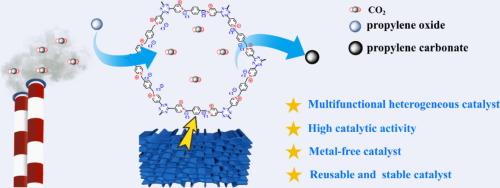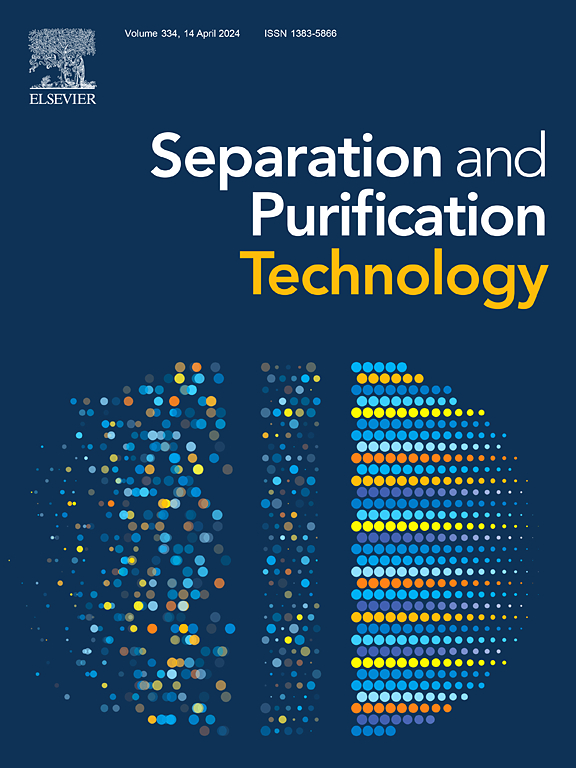Multifunctional ionic covalent triazine framework as heterogeneous catalysts for efficient CO2 cycloaddition
IF 8.1
1区 工程技术
Q1 ENGINEERING, CHEMICAL
引用次数: 0
Abstract
The abundant triazine rings with the good affinity for CO2 molecules in covalent triazine frameworks (CTFs) can capture and activate CO2 molecules, making CTFs a potential candidate for CO2 cycloaddition reaction. However, due to the single active site, the realization of high catalytic performance commonly requires the assistance of cocatalysts or harsh reaction conditions. In this study, several novel ionic covalent triazine frameworks (MCTFs, BCTFs and YCTFs) multifunctional heterogeneous catalysts were synthesized for CO2 cycloaddition reactions. The prepared CTFs catalysts have outstanding pore structure and uniformly distributed active sites (N Lewis basic sites in triazine ring and Cl– nucleophilic sites). The optimal catalyst MCTF-10 has good CO2 enrichment capacity and high adsorption selectivity. In addition, the catalyst shows an outstanding catalytic performance for the coupling reaction of CO2 and propylene oxide, with 96 % of yield and 99 % of selectivity for the product under metal-, solvent- and cocatalyst-free parameters (110 °C, initial CO2 pressure 1 MPa, 4 h). Even under diluted CO2 concentration (15 % CO2, 85 % N2) and mild conditions (80 °C, 0.1 MPa, 24 h), the synthetized CTFs exhibits an outstanding catalytic activity. The excellent catalytic performance, along with the good cycling stability and broad applicability of epoxides, make it a competitive catalyst for catalyzing the CO2 cycloaddition reaction.

多功能离子共价三嗪框架作为高效 CO2 环加成的异相催化剂
共价三嗪框架(CTFs)中丰富的三嗪环对二氧化碳分子具有良好的亲和性,可以捕获和活化二氧化碳分子,使其成为二氧化碳环加成反应的潜在候选物质。然而,由于活性位点单一,要实现高催化性能通常需要助催化剂的辅助或苛刻的反应条件。本研究合成了几种新型离子共价三嗪框架(MCTFs、BCTFs 和 YCTFs)多功能异相催化剂,用于 CO2 环加成反应。所制备的 CTFs 催化剂具有优异的孔隙结构和均匀分布的活性位点(三嗪环中的 N Lewis 碱性位点和 Cl- 亲核位点)。最佳催化剂 MCTF-10 具有良好的二氧化碳富集能力和较高的吸附选择性。此外,该催化剂在二氧化碳与环氧丙烷的偶联反应中表现出卓越的催化性能,在不含金属、溶剂和助催化剂的参数条件下(110 °C,初始二氧化碳压力 1 兆帕,4 小时),产率达 96%,产物选择性达 99%。即使在稀释的二氧化碳浓度(15 % CO2、85 % N2)和温和条件(80 °C、0.1 兆帕、24 小时)下,合成的 CTFs 也表现出卓越的催化活性。优异的催化性能、良好的循环稳定性和对环氧化物的广泛适用性,使其成为催化 CO2 环加成反应的一种极具竞争力的催化剂。
本文章由计算机程序翻译,如有差异,请以英文原文为准。
求助全文
约1分钟内获得全文
求助全文
来源期刊

Separation and Purification Technology
工程技术-工程:化工
CiteScore
14.00
自引率
12.80%
发文量
2347
审稿时长
43 days
期刊介绍:
Separation and Purification Technology is a premier journal committed to sharing innovative methods for separation and purification in chemical and environmental engineering, encompassing both homogeneous solutions and heterogeneous mixtures. Our scope includes the separation and/or purification of liquids, vapors, and gases, as well as carbon capture and separation techniques. However, it's important to note that methods solely intended for analytical purposes are not within the scope of the journal. Additionally, disciplines such as soil science, polymer science, and metallurgy fall outside the purview of Separation and Purification Technology. Join us in advancing the field of separation and purification methods for sustainable solutions in chemical and environmental engineering.
 求助内容:
求助内容: 应助结果提醒方式:
应助结果提醒方式:


